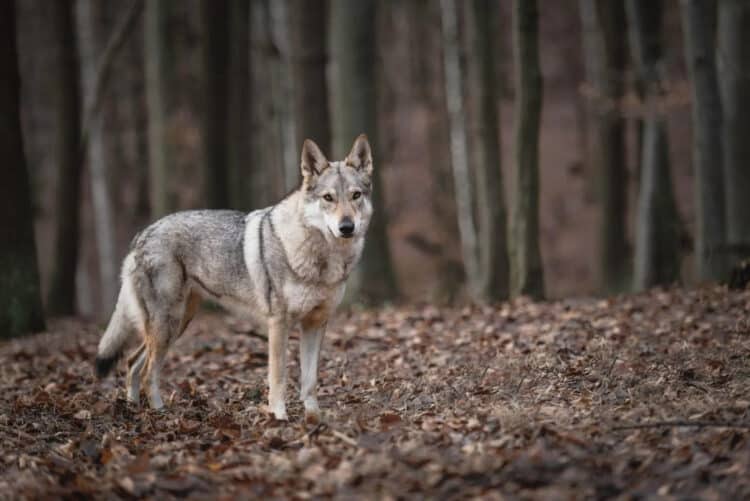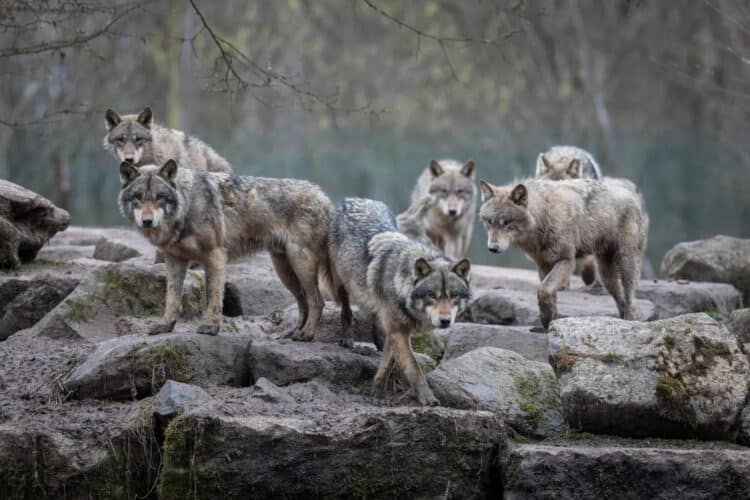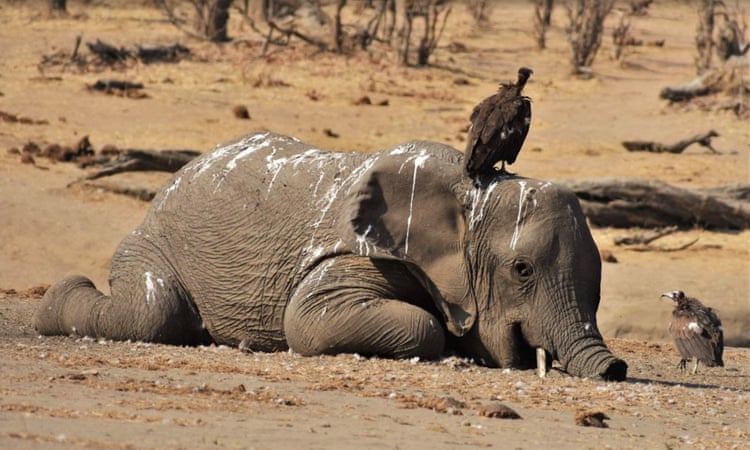Gray wolves once roamed the entire North American continent, from the scrubby deserts of Mexico to the boreal forests of Alaska. But by the 1950s decades of overhunting and habitat loss had nearly extirpated the species in the contiguous United States. In a remarkable conservation success story, the 1973 Endangered Species Act (ESA) helped push the number back up to about 7,500 gray wolves in the lower 48 states as of 2020.
These iconic roaming carnivores are at a crossroads again, following a decision-making process initiated in 2019. The U.S. Department of Fish and Wildlife deemed gray wolves’ recovery so successful that it fully “delisted” the canids from the ESA starting on January 4, 2021. This removed them from federal protection and left management of the species up to individual states. Michigan and Minnesota are in the early stages of planning potential hunts in 2022. Meanwhile Montana and Idaho, whose wolf populations have been delisted since 2011, have loosened restrictions: In April Montana legalized the use of snares to capture wolves, and in May Idaho passed a law allowing the cull of 90% of the state’s population by nearly all means, including shooting from helicopters or ATVs.
Wisconsin moved swiftest of all, implementing a “harvest” this past February after a hunting advocacy group sued its Department of Natural Resources (DNR) to schedule an immediate wolf hunt. Wisconsin law had required an annual hunt to occur between mid-October and the end of February if the gray wolf was delisted. The state initially planned to wait for the fall of 2021 to hold a harvest. But the lawsuit forced its hand, and between February 22 and 24, hunters killed 218 wolves, according to the Wisconsin DNR. That works out to about 21 percent of the state’s 2020 population estimate of 1,034 of the animals, which would leave 816 in Wisconsin.
But the actual number of Wisconsin wolves that have perished in the past year is higher, according to a recent study published in Peer J–Life & Environment. In it, researchers estimate that nearly one third of the state’s total wolf population was wiped out during that time, bringing the real figure to somewhere between 695 and 751 animals by mid-April. When it announced the harvest quota for the February 2021 hunt, the Wisconsin DNR said its goal was to neither increase nor decrease the gray wolf population. But the study argues that the state agency’s calculations failed to keep the population stable.
“The state was trying to maintain a tolerable level of mortality” through the February hunt, says Adrian Treves, a carnivore ecologist at the University of Wisconsin–Madison and an author of the study. “They didn’t.”
Now the wolves are set to face hunters a second time this year. On August 11 the Wisconsin Natural Resources Board, which sets natural resources policy for the state, approved a quota of up to 300 additional wolves to be hunted in the fall season, starting on November 6.
The two hunts in Wisconsin could have a devastating long-term impact on gray wolves in the Great Lakes region and the ecosystem in which they live, some experts say. Rapidly removing a large portion of the animals will likely harm their natural reproduction process and ensure that new births cannot restore the population to its 2020 size, according to scientists. And a swift removal of wolves from the land twice in one year could have unseen effects that would ripple through the ecosystem for years to come.
Treves’s team came up with the figure of one third of Wisconsin’s gray wolves by integrating three causes of population loss: official kills in the February hunt, as reported by the state’s DNR, natural deaths and unreported kills. The latter category can be difficult to track, and it includes “cryptic poaching,” which killed 55 to 58 wolves between April 2020 and April 2021, according to the researchers’ estimates. They contend that the delisting deliberations throughout 2020 created an atmosphere that “liberalized” the killing of wolves and led to a rise in poaching.
Randy Johnson, a specialist in large carnivores at the Wisconsin DNR, criticizes the team’s one third estimate because it fails to account for any births that followed the hunt this past spring. But DNR data show that of the 218 wolves killed, 38 were breeding-age females. Wolves reproduce only once a year, usually between January and March, and scientists say pregnant or nursing females were likely killed in the February hunt. This, they say, would limit the number of spring births.
Even if none of the hunted wolves in February were pregnant, normal levels of breeding in the remaining females might not be enough to keep the population stable, says Adrian Wydeven, a retired wildlife biologist who worked for the state of Wisconsin for more than three decades. “If the intent of the DNR was to keep the population at the level it was…, it would almost take two or three years of zero wolf harvest to even get back to that level” of 900 or 1,000 wolves, he says. Using methods independent of Treves’s work, Wydeven also estimates “about 700 or so wolves” remain in the postharvest population.
Wydeven worries that the National Resources Board’s decision to approve a fall harvest quota of 300 wolves could push the state population as low as 350—a figure put forth in a 1999 wolf management plan he co-wrote. In the plan, that number was meant to serve as the minimum amount of wolves for researchers to aim for before the state could consider any hunting of the animals first place, not as an ideal population size, he says.
Whether the Wisconsin wolf population is currently closer to 700 or 800, Wydeven and Treves agree that the losses from February’s hunt alone (not to mention up to 300 more from the upcoming fall hunt) could have effects throughout the landscape. For his part, Johnson says, “there’s no question [wolves] have impacts on the environment around them. To characterize any as good or bad, positive or negative, is really a human interpretation.” He would not comment directly on any impacts of the hunt set for this fall.
Wydeven’s concerns rest on long-established ethological insights into the wolf pack, a tight-knit family unit that includes a breeding pair, their offspring and other related adults. “The assumption is the normal ecological functions you see from wolves are mainly [done] through the packs,” he says. The February hunt likely broke up packs by killing a breeding animal or several or all members of the same unit, Treves explains. Straggling members of a ruptured pack “don’t hunt deer as effectively,” he says.
The disruption of packs and their hunting does not necessarily mean an imminent explosion in the deer population. But wolves cull sick deer, notably animals with chronic wasting disease, or CWD, which is caused by a contagious neurological pathogen. The disease has become a serious problem among white-tailed deer in southern Wisconsin—where there are no wolves—Wydeven says. Meanwhile the illness is almost never seen in northern parts of the state, “where we’ve got healthy packs of wolves,” he says. The loss of individual wolves and healthy packs could mean a CWD uptick and more unhealthy deer, a concerning prospect, Wydeven adds.
Wolves also have an impact on deer-vehicle collisions, a significant problem in Wisconsin that costs the state about $200 million a year, according to estimates made from federal data. A June analysis estimates a 24 percent reduction in such collisions over a 22-year period in Wisconsin counties where wolves were present. Wolves hunt and eat deer, but the predators’ mere presence also sparks behavioral changes in their prey, notes that study’s lead author Jennifer Raynor, a natural resources economist at Wesleyan University. Deer grow more fearful and reluctant to traipse through areas with wolves, bringing down their interactions with cars and 18-wheelers, she says.
Beyond the roadways, the rebounding wolf population has contributed to a resurgence of certain plant species in Wisconsin by influencing what deer eat and where they do so. The animals wipe out large swaths of the tasty plants they prefer, stunting the plants’ ability to grow back, Wydeven says. As Johnson puts it, “They eat the candy of the forest.”
In areas with healthy, functioning wolf packs, “we are starting to detect some level of reduced [deer] grazing,” Wydeven says. Research suggests that the longer a pack is in place in a location, the more likely it is to have a greater diversity of native flowers and a higher number of tree seedlings, he says.
Where the gray wolves’ comeback goes from here remains to be seen, particularly if the fall hunt and its quota of 300 animals stays in place. Growing up in northern Wisconsin in the 1960s, Wydeven recalls reading in the local paper about rumors that one or two lone wolves were roaming in the wild, forested border area between Wisconsin and Michigan’s Upper Peninsula. “We thought we probably never would again have a wolf population because the state was just not [thought to be] a wild enough place to support wolves,” he says. “So, for us, going from zero to 1,000 wolves is pretty amazing.”
This article by Tess Joosse was first published by Scientific American on 7 September 2021. Lead Image: Gray wolf in northern Wisconsin. Credit: Linda Freshwaters Arndt Alamy.
What you can do
Support ‘Fighting for Wildlife’ by donating as little as $1 – It only takes a minute. Thank you.
Fighting for Wildlife supports approved wildlife conservation organizations, which spend at least 80 percent of the money they raise on actual fieldwork, rather than administration and fundraising. When making a donation you can designate for which type of initiative it should be used – wildlife, oceans, forests or climate.







Leave a Reply